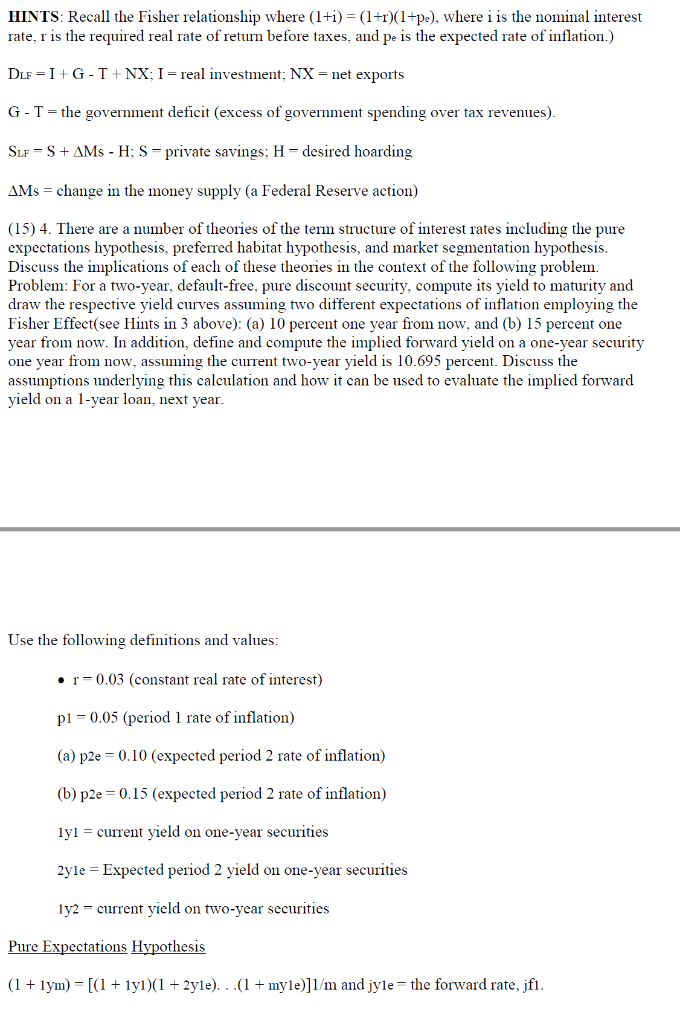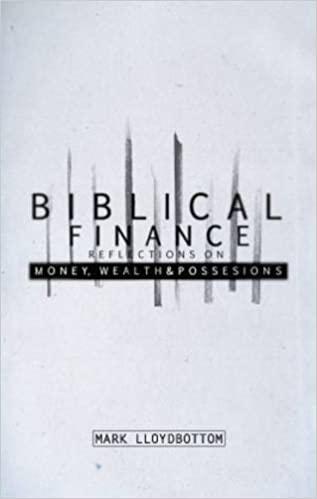HINTS: Recall the Fisher relationship where (1+i) = (1+r)(1+pe), where i is the nominal interest rate, r is the required real rate of return before taxes, and pe is the expected rate of inflation.) DLF = I + G - T + NX; I = real investment; NX = net exports G - T = the government deficit (excess of government spending over tax revenues). SLF = S + Ms - H; S = private savings; H = desired hoarding Ms = change in the money supply (a Federal Reserve action)
There are a number of theories of the term structure of interest rates including the pure expectations hypothesis, preferred habitat hypothesis, and market segmentation hypothesis. Discuss the implications of each of these theories in the context of the following problem. Problem: For a two-year, default-free, pure discount security, compute its yield to maturity and draw the respective yield curves assuming two different expectations of inflation employing the Fisher Effect(see Hints in 3 above): (a) 10 percent one year from now, and (b) 15 percent one year from now. In addition, define and compute the implied forward yield on a one-year security one year from now, assuming the current two-year yield is 10.695 percent. Discuss the assumptions underlying this calculation and how it can be used to evaluate the implied forward yield on a 1-year loan, next year. Use the following definitions and values: r = 0.03 (constant real rate of interest) p1 = 0.05 (period 1 rate of inflation) (a) p2e = 0.10 (expected period 2 rate of inflation) (b) p2e = 0.15 (expected period 2 rate of inflation) 1y1 = current yield on one-year securities 2y1e = Expected period 2 yield on one-year securities 1y2 = current yield on two-year securities Pure Expectations Hypothesis (1 + 1ym) = [(1 + 1y1)(1 + 2y1e). . .(1 + my1e)]1/m and jy1e = the forward rate, jf1.

HINTS: Recall the Fisher relationship where (1+i)= (1+r)(1+pe), where i is the nominal interest rate, r is the required real rate of return before taxes, and pe is the expected rate of inflation.) DLF I+G-T+NX; I = real investment; NX = net exports G-T= the government deficit (excess of government spending over tax revenues). SLE = S + AMs - H; S = private savings; H = desired hoarding AMs = change in the money supply (a Federal Reserve action) (15) 4. There are a number of theories of the term structure of interest rates including the pure expectations hypothesis, preferred habitat hypothesis, and market segmentation hypothesis. Discuss the implications of each of these theories in the context of the following problem. Problem: For a two-year, default-free, pure discount security, compute its yield to maturity and draw the respective yield curves assuming two different expectations of inflation employing the Fisher Effect (see Hints in 3 above): (a) 10 percent one year from now, and (b) 15 percent one year from now. In addition, define and compute the implied forward yield on a one-year security one year from now, assuming the current two-year yield is 10.695 percent. Discuss the assumptions underlying this calculation and how it can be used to evaluate the implied forward yield on a 1-year loan, next year. Use the following definitions and values: r=0.03 (constant real rate of interest) pl = 0.05 (period 1 rate of inflation) (a) p2e = 0.10 (expected period 2 rate of inflation) (b) p2e = 0.15 (expected period 2 rate of inflation) 1y1 = current yield on one-year securities 2yle = Expected period 2 yield on one-year securities 1y2 = current yield on two-year securities Pure Expectations Hypothesis (1 + lym) = [(1 + 1y1)(1 + 2yle)...(1 + myle)]l/m and jyle= the forward rate, jfl. HINTS: Recall the Fisher relationship where (1+i)= (1+r)(1+pe), where i is the nominal interest rate, r is the required real rate of return before taxes, and pe is the expected rate of inflation.) DLF I+G-T+NX; I = real investment; NX = net exports G-T= the government deficit (excess of government spending over tax revenues). SLE = S + AMs - H; S = private savings; H = desired hoarding AMs = change in the money supply (a Federal Reserve action) (15) 4. There are a number of theories of the term structure of interest rates including the pure expectations hypothesis, preferred habitat hypothesis, and market segmentation hypothesis. Discuss the implications of each of these theories in the context of the following problem. Problem: For a two-year, default-free, pure discount security, compute its yield to maturity and draw the respective yield curves assuming two different expectations of inflation employing the Fisher Effect (see Hints in 3 above): (a) 10 percent one year from now, and (b) 15 percent one year from now. In addition, define and compute the implied forward yield on a one-year security one year from now, assuming the current two-year yield is 10.695 percent. Discuss the assumptions underlying this calculation and how it can be used to evaluate the implied forward yield on a 1-year loan, next year. Use the following definitions and values: r=0.03 (constant real rate of interest) pl = 0.05 (period 1 rate of inflation) (a) p2e = 0.10 (expected period 2 rate of inflation) (b) p2e = 0.15 (expected period 2 rate of inflation) 1y1 = current yield on one-year securities 2yle = Expected period 2 yield on one-year securities 1y2 = current yield on two-year securities Pure Expectations Hypothesis (1 + lym) = [(1 + 1y1)(1 + 2yle)...(1 + myle)]l/m and jyle= the forward rate, jfl







